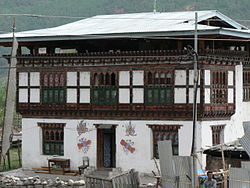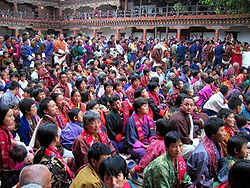- Driglam namzha
-
The Driglam Namzha (Tibetan: སྒྲིག་ལམ་རྣམ་གཞག་, Wylie: sgrig-lam rnam-gzhag) is the official behaviour and dress code of the Kingdom of Bhutan. It governs how citizens should dress in public and how they should behave in formal settings. It also regulates a number of cultural assets such as art and architecture. In English, driglam means "order, discipline, custom, rules, regimen"[1] and namzha means "system,"[1] though the term may be styled "The Rules for Disciplined Behaviour."
Contents
History of the Driglam Namzha
The Driglam Namzha traces its roots directly back to the 17th century pronouncements of Shabdrung Ngawang Namgyel, the Tibetan lama and military leader who unified Bhutan as a nation state. Charismatic and forward thinking, the Shabdrung sought to unify the country not only politically but culturally as well. He established guidelines for building the characteristic fortresses of Bhutan, known as dzongs. He also established many of the traditions of the tsechu or district festival, such as specific sacred dances known as cham. These guidelines were intentionally codified to encourage the emergence of a distinctive Bhutanese identity.
In 1989 the government elevated the status of the dress code from recommended to mandatory. Afterward, all citizens were required to observe the dress code in public during business hours. This decree was resented by the Hindu Lhotshampas in the southern lowlands who voiced complaints about being forced to wear the clothing of the Ngalop.[2][3] Soon thereafter approximately 80,000 Nepalese left the country who did not want to follow the process of Driglma Namzha as undocumented aliens and now reside in refugee camps in Nepal.[citation needed]
Clothing
Under the Driglam Namzha, men wear a heavy knee-length robe tied with a belt, called a gho, folded in such a way to form a pocket in front of the stomach. Women wear colorful blouses called wonju over which they fold and clasp a large rectangular cloth called a kira, thereby creating an ankle-length dress. A short silk jacket, or toego may be worn over the kira. Everyday gho and kira are cotton or wool, according to the season, patterned in simple checks and stripes in earth tones. For special occasions and festivals, colourfully patterned silk kira and, more rarely, gho may be worn.
Additional rules apply when visiting a dzong or a temple, and when appearing before a high level official. A white sash called a kabney is worn by male commoners from left shoulder to opposite hip, with other colors reserved for officials and monks. Women wear a rachu, a narrow embroidered cloth draped over the left shoulder.
Architecture
Main article: Architecture of Bhutan A Bhutanese house in Paro with multi-colored wood frontages, small arched windows, and a sloping roof
A Bhutanese house in Paro with multi-colored wood frontages, small arched windows, and a sloping roof
The Driglam Namzha codifies the traditional rules for the construction of the sacred fortresses or dzongs. No plans are drawn up, nor are nails allowed in the construction. Under the direction of an inspired lama the fortress is constructed by the citizens who participate as part of their tax obligation to the state. As recently as 1998, by royal decree, all buildings must be constructed with multi-coloured wood frontages, small arched windows, and sloping roofs.[2]
See also
- Culture of Bhutan
- History of Bhutan
- Dzong architecture
- Lhotshampa
- Bhutanese refugees
Notes
- ^ a b "Dharma Dictionary". Diamond Way Buddhism. 1996. http://www.diamondway-buddhism.org/diction/diction.htm. Retrieved 2010-10-01.
- ^ a b "Country profile – Bhutan: a land frozen in time". BBC News online. 1998-02-09. http://news.bbc.co.uk/2/hi/country_profile/54627.stm. Retrieved 2010-10-01.
- ^ "Bhutan country profile". BBC News online. 2010-05-05. http://news.bbc.co.uk/2/hi/south_asia/country_profiles/1166513.stm. Retrieved 2010-10-01.
Bhutanese Society Culture 
Religion Ethnic Groups Law & Politics Censorship · Democracy · Driglam namzha · Elections and voting · Gross National Happiness · Human rights · Immigration · LGBT rights · Refugees (in Nepal) · Religious freedom · Tobacco lawsBhutanese Law Sources 
Institutions & Agencies Attorney General · Judicial system: Royal Court of Justice · Ministry of Home and Cultural Affairs: Police & Prisons · ParliamentCourts Issues Capital punishment · Censorship · Crime · Driglam namzha · Elections and voting · Human rights · Immigration · Law enforcement · LGBT rights · Local governance (decentralization) · Refugees · Religious freedom · Taxation · Tobacco lawsCategories:- Bhutanese culture
- Bhutanese fashion
- Bhutanese architecture
Wikimedia Foundation. 2010.

